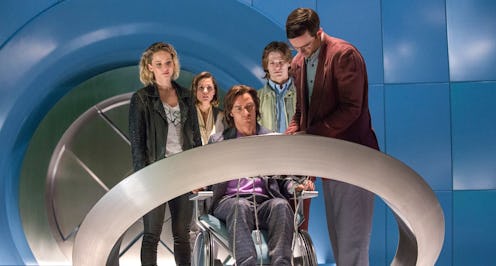
With superhero movie reboots constantly futzing with timelines, it can be confusing to remember when exactly a certain franchise is supposed to be taking place. (By the way, Spider-Man is 15 again.) The current X-Men trilogy went so far as to completely wipe out the events of the 2006 sequel X-Men: The Last Stand, and some of what came before. You probably know that X-Men: Apocalypse is set after the action of X-Men: Days Of Future Past, and you might know also that new versions of X-Men like Jean Grey, Nightcrawler, and Cyclops, who were played by older actors in the 2000 film, have been recruited for this particular showdown. Chronologically, X-Men: Apocalypse takes place sometime between Days Of Future Past and the first live-action X-Men movie.
Well, I can only hope that the era will inform a lot of the movie's soundtrack and wardrobe, because X-Men: Apocalypse is set in 1983. This timing was in the works as far back as two years ago. Producer Simon Kinberg told the hosts of the Q&A Podcast (as reported by Den Of Geek) that X-Men: Apocalypse would pick up a full decade after Days Of Future Past left off. (The main story in 1973, not the "New Future" scene where Logan sees his comrades at Dr. X's school back in the present.) That's no bigger a jump than what took place between the first two prequels. Never forget a young Charles Xavier picking up co-eds in the swingin' '60s by praising their "groovy" mutations. (Kinberg recently confirmed to ComingSoon.net that the pattern will continue; the next X-Men film will be set in the '90s.)
The X-Men marketing team is already having fun with its distinctive and stylistically garish period setting. Check out the very '80s school fashion in the promo above and the "commercial" for Xavier's School For Gifted Youngsters below. The latter features Jubilee (Lana Condor) as a cheery spokesgirl, a synth-y soundtrack, and a lot of lasers and screen wipes. It's a pitch-perfect parody of every ancient after-school special a teacher ever popped into your school's TV/VCR combo.
Besides whether legwarmers and spandex will figure significantly into the mutants' wardrobe, the big question that the timing of the movie sets up is this: is X-Men: Apocalypse limited by a responsibility to set plot and characters up for that first X-Men movie? Director Brian Singer told Collider that the he chose not to operate under that burden and instead committed to "playing with time’s immutability and the prequel concept." Basically, you should still be very worried about all the characters you love, even the ones who are very much alive in the previous trilogy. "That means the audience goes into the movie thinking that anything can happen," Singer says, "I mean anything, anyone could die." But what about the flash-forward scene in Days Of Future Past? Even if the prequels retconned the rest, that sequence must represent the new present-day reality the X-Men are now moving towards. Singer explains: "All these movies now exist in the same timeline and certainly the intention at the end of Days of Future Past was that final future we saw was the destination for the characters."
Still, no one and no future is safe in the X-Men: Apocalypse version of 1983. "Time can always be f***ed with," Singer told Collider. "We've now learned that."
Image: 20th Century Fox